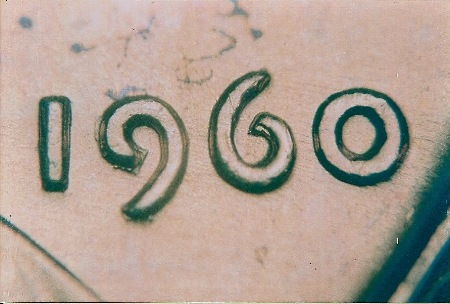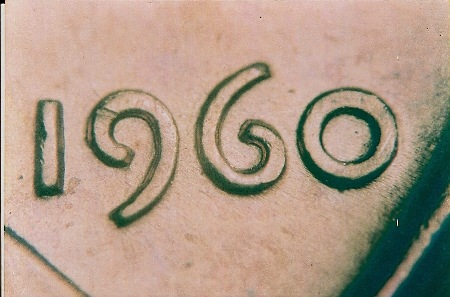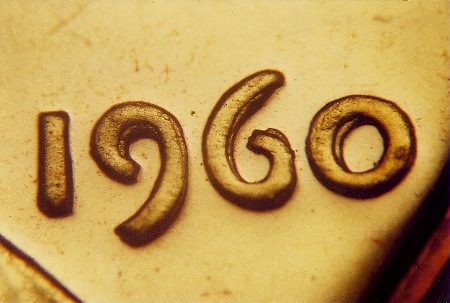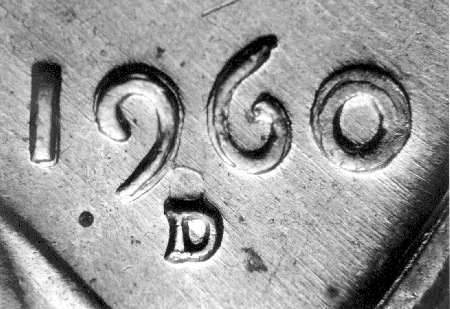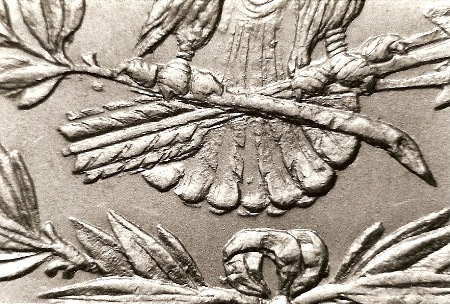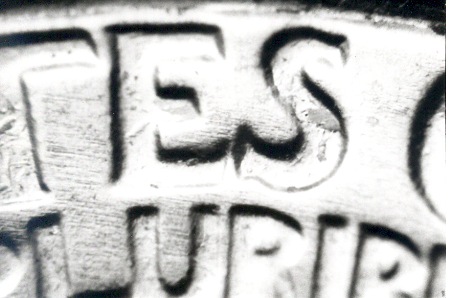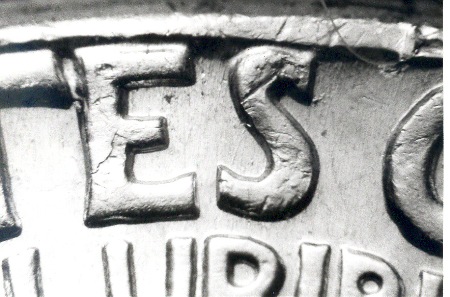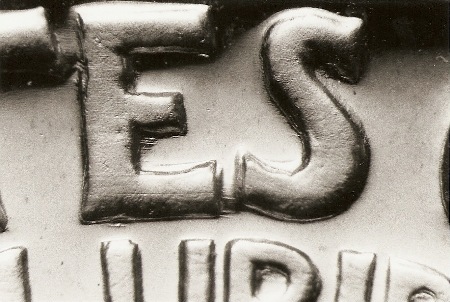


 |
 |
 |
 |
 |
 |
 |
 |
 |
 |
 |
 |
 |
 |
 |
 |
 |
 |
 |
 |
 |
 |
 |
 |
Probably the easiest class of doubled dies to explain and to understand is the Class III doubled die variety. This is also the class of doubled dies with one of the fewest known number of documented varieties for each denomination and series. Doubled dies in this class are produced when a working die receives impressions from working hubs bearing two different or partially different designs. Doubled images resulting from differences in the design may occur when two different designs are used in the same year, or from the fact that hubs were used from two different years. One of the best known examples of a Class III doubled die on the Lincoln cents occurred in 1960. That year the Mint used two different designs on the Lincoln cent. At the beginning of the year cents were made from working dies that had a "Small Date." The Mint had a lot of die chipping problems with these dies and after a few months the Mint modified the design to one bearing a significantly larger date. As a result, collectors can obtain 1960 and 1960-D Lincoln cents with either the "Small Date" design or the "Large Date" design. Proof coins for that year can also be obtained with either design. Of importance to doubled die collectors is the fact that during 1960 three different proof dies were prepared which received hubbings from both designs. Two different proof dies were made which first had the "Small Date" hubbed into the die and then had the "Large Date" hubbed into the die. The result was two different proof dies with "Large Date/Small Date" varieties. Since the Large Date was the final and deepest hubbing, the appearance on the coins is that of the Large Date superimposed over the Small Date.
This is the 1960 Lincoln cent Small Date design used at the beginning of the year.
Here we seen the 1960 Large Date design used on the Lincoln cents produced after the Mint experienced problems with the Small Date design.
This is the 1960 Lincoln cent doubled die variety listed in the Wexler Files as 1960 1¢ Pr WDDO-003. It has a Large Date hubbed over a Small Date. The variety that we have listed as 1960 1¢ Pr WDDO-001 shows similar doubling to the date and was produced the same way as this one. One proof die produced that year had the exact opposite sequence of hubbings. First it received an impression from a Large Date hub and then it received an impression from a Small Date hub. Coins from this die have a "Small Date/Large Date" variety with the Small Date seemingly sitting on top of the Large Date.
Seen here is the 1960 proof cent doubled die listed as 1960 1¢ Pr WDDO-002. It has the Small Date hubbed over the Large Date. That year one Denver Mint die was also prepared with the "Small Date/Large Date" sequence of hubbings. This variety also sports a very widely spread RPM variety. Though not as rare as its proof counterparts, it is an extremely popular variety with collectors and commands a significant premium, especially for early die state specimens.
Here is the 1960-D "Small Date/Large Date" variety. Notice how the Small Date appears to be resting on the Large Date. This variety is listed in our files as 1960-D 1¢ WDDO-001. Also notice the extra mint mark well north of the main mint mark. This is not part of the doubled die doubling. The application of the mint mark was a completely separate process from hubbing the die for the design. What many collectors may not be aware of is the fact that all 20th century overdates are actually Class III doubled die varieties. They were created by using working hubs from two different years on the same working die. Examples of this include the 1918/7-D Buffalo nickel, the 1918/7-S Standing Liberty Quarter, the 1942/1 and 1942/1-D Mercury Dimes, and the 1943/2-P Jefferson Nickel.
This 1942/1 Mercury Dime overdate is actually a Class III doubled die variety. It first received an impression from a working hub with the 1941 date and then an impression from a working hub with the 1942 date. Whether these overdates were accidentally or intentionally produced is not known. Since all of these varieties were produced on coins set in the time frame of the World Wars, speculation has it that they may have been produced intentionally. This theory suggests that since these were difficult times, the varieties may be the result of a money saving effort on the part of the Mint. In each case there may have been a leftover die from that year and rather than waste an otherwise good die, the die was rehubbed with a hub bearing the date of the next year. We may never know for sure if they were accidental or intentional, but there is one thing that we do know for sure. They are extremely popular and very valuable. Due to the different designs and the conditions necessary to produce Class III doubled die varieties, this class has one of the fewest number of listings. In the early days of doubled die research this class turned out to be a dumping ground for varieties that did not appear to fit into the other classes. The reasoning at the time was that if the doubling could not be explained by any of the other class causes, it must be due to some sort of design difference. We know better today. Just because we may not know exactly what caused the doubling on some varieties, it does not necessarily mean that design differences were the culprit. Many older listings with Class III designations have since been reclassified. I personally will not assign a Class III designation to a doubled die variety unless I have documented evidence that different designs were in use the year that the doubled die was produced. Design differences are known for certain series and have resulted in some interesting doubled dies. The 1878 Morgan Dollars were minted with two different reverse designs that year. On the first design the eagle had 8 tailfeathers. On the second design the eagle had 7 tailfeathers. Several working dies were hubbed that year producing varieties with 7 tailfeathers hubbed over 8 tailfeathers.
This is one of several 7/8 tailfeather varieties on the reverse of the 1878 Morgan dollars. An early impression was made with a hub containing the 8 tailfeather design and the final impression(s) were made with a hub containing the 7 tailfeather design. It is a classic Class III doubled die variety and is listed in the Wexler Doubled Die Files as 1878 $1 WDDR-002. For the collectors of VAM varieties, it is listed as VAM 38. On the Franklin Half dollars there were differences on the eagles on the reverse. The proof dies had one style of eagle and the circulation dies had a different style. At least one doubled die is known to be a mating of these two designs. Likewise, the Washington quarters are known to have different reverse designs for the proof and circulation strike coins. The circulation strike coins through 1964 have a "Close ES" on the word STATES while on the proof design there is a wider separation on the E and S (Wide ES design). In 1952 two different proof dies were made with hubbings from both a Close ES hub and a Wide ES hub.
This is the Close ES design used on the reverse of circulation strike quarters through 1964.
This is the Wide ES design used on the reverse of proof strike quarters through 1964.
This is one of the 1952 prooof reverse dies produced that year with a Wide ES hubbed over a Close ES. It is listed in my files as 1952 25¢ Pr WDDR-001 and is another example of a Class III doubled die variety.
This strong doubling on the L of PLURIBUS can also be found on the Class III doubled die listed as 1952 25¢ Pr WDDR-001. A marvelous collection of this type of doubled die can be made by obtaining coins bearing each of the different designs and the doubled die variety with the mating of those designs. At this point it would not be a tremendously large collection, but it would be an expensive one due to the number of overdates that would be needed to complete the collection. Go To: | ||


